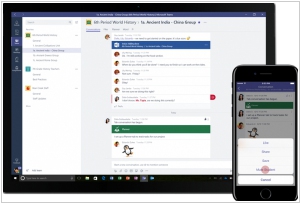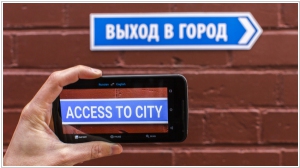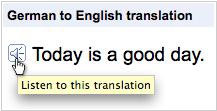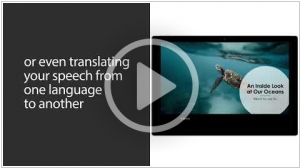Real-time translation services
Updated: August 01, 2023
Real-time translation services are advanced language solutions that provide instant and accurate translation of spoken or written content between different languages. These services leverage machine learning and artificial intelligence to interpret and translate conversations, meetings, documents, or web pages in real-time. Real-time translation services can be integrated into communication tools like video conferencing platforms, messaging apps, and web browsers, enabling seamless multilingual communication across borders and cultures. With the ability to support a wide range of languages and dialects, these services break down language barriers, facilitate global collaboration, and enhance cross-cultural communication. Real-time translation services play a pivotal role in various industries, including international business, travel, education, and customer support, providing a transformative solution for fostering effective communication in a diverse and interconnected world.
See also: Top 10 Online Translators
See also: Top 10 Online Translators
2018. Skype and PowerPoint got real-time subtitles
PowerPoint and Skype have announced the upcoming introduction of real-time captions and subtitles in 2019. This new feature is designed to provide accessibility for individuals who are deaf or hard of hearing, enabling them to read the spoken words during PowerPoint presentations or video calls on Skype. Moreover, the subtitles offer the capability to include presentation translations. The live captions and subtitles will support 12 spoken languages and display on-screen in over 60 different languages. Presenters will have the ability to customize the appearance of the subtitles to align with their presentation's visual style, and the speech recognition technology will adapt to provide more accurate terminology based on the context. In Skype, the subtitles will be available during one-to-one video calls and will automatically scroll on the screen. Microsoft has also mentioned that they are working on providing additional viewing options, including the ability to scroll through the captions in a side window.
2018. Microsoft Teams will integrate with Cortana

Microsoft Teams, the team collaboration software developed by Microsoft and a competitor to Slack, has unveiled a range of new features that will be gradually introduced to the software in 2018. These features include the ability to record, transcribe, and save meetings to the cloud, integrations with the voice assistant Cortana, inline message translation, and more. The integration with Cortana's voice assistance functionality could potentially give Microsoft an advantage in its competition with Slack, considering the growing significance of voice-based computing in the workplace and productivity applications.
2016. Skype adds real-time translation to all VoIP calls

In a significant development, Skype introduced its integrated Translator feature last year, enabling real-time speech translation. Initially, this feature was only available in video chats, but the latest version brings the capability to make calls worldwide and have your conversations instantly interpreted, regardless of whether the other person is using a traditional rotary phone. When initiating a call, users simply need to select their preferred language, and the tool will handle the rest. The recipient will hear a message stating that the call is being recorded and translated through the service, which becomes evident once the conversation begins. The new feature will be initially accessible to members of the Windows Insider Program. Presently, the Translator supports nine spoken languages: English, Spanish, French, German, Mandarin Chinese, Italian, Brazilian Portuguese, Arabic, and Russian.
2015. Google Translate now does real-time voice and written text translation

The mobile app for Google Translate on Android and iOS has received an impressive update, enhancing its capabilities even further. The latest update introduces two remarkable features: real-time voice translation and sign translation. While the app has previously offered image-based translation, these new features provide instant translation with zero delay, and the best part is that they work offline, making it incredibly useful for frequent travelers. To translate a sign, you simply need to point your camera at it, ensuring it is captured completely, and the app will promptly provide the translation. The real-time voice translation feature is equally impressive, acting as an intermediary for conversations between individuals speaking different languages. By tapping the in-app microphone once and initiating the conversation in the foreign language, the app recognizes the language and allows both parties to communicate. As the conversation progresses, the app continuously generates text-based translations in real-time, effectively breaking down language barriers.
2014. Video: real-time voice translator in Skype
Microsoft's Bing Translator, an online translation service, has always been overshadowed by Google Translate. All the advancements, such as full text translation, mobile support, voice recognition, and translation playback, initially debuted in Google Translate before being replicated in Bing Translator. However, Microsoft has now taken the lead. During the CodeConf conference, Satya Nadella showcased a voice translator in Skype that can recognize phrases in one language and play them back in another (almost) instantly. This breakthrough enables individuals from different countries to communicate in their native languages. Currently, the feature only supports English and German, but Satya mentioned that a working version with additional languages will be available in Skype before the end of this year.
2009. Google Translate now translates in real time

In the near future, the advancement of text and speech translation technology will become increasingly crucial for the virtual economy. Language acts as a significant barrier that hinders collaboration among talented individuals from different countries on shared projects. Therefore, we hold high hopes for Google Translate as an innovative service that breaks down this barrier. Today, Google has released a new version of the service, introducing several useful features. Firstly, the service now provides real-time translation results as you type. Secondly, when translating from any language into English, you can listen to the translated text, allowing for the practice of pronunciation. Furthermore, a Romanization feature has been added. For instance, when translating into Chinese, the translation can be read in Roman letters. Another noteworthy feature is the automatic language detection for the original text. Additionally, when you need to translate a web page, you can simply enter its URL into the text entry field.



